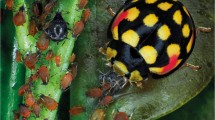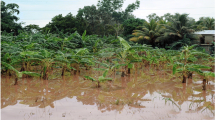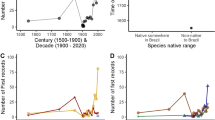Abstract
One of the consequences of global change, especially demographic and climatic, will be a demand for novel plant germplasm of all kinds suited to the new ecoclimatic conditions predicted and plant introduction will assume a new importance. As a consequence, botanic gardens will face an unprecedented opportunity to regain their role as introduction centres and become major actors in the assessment of new germplasm, both of ornamentals as well as other economically important plants. Plant introduction has remained largely unchanged over the past 400 years and is as often ad hoc, poorly organized and insufficiently collaborative, but if it is to meet the needs of today’s situation it needs to be overhauled. In particular: (1) the basis of plant introduction needs to be broadened; (2) closer cooperation with agricultural genebanks should be established; (3) agreement should be reached between botanic gardens and the agricultural sector on their respective responsibilities (4) the quality and sampling of the accessions should be more strictly controlled; (5) proper evaluation of the introductions before they are disseminated; (6) information on the accessions of introduced plants and their fate needs to be more effectively maintained and disseminated; and (7) full cognizance should be taken of policies to protect against invasive species and care should be taken to evaluate the risks that new introductions might represent. Finally, consideration should be given to preparing a set of guidelines or even a code of conduct for plant introductions by botanic gardens in association with other agencies.
Similar content being viewed by others
Notes
The US Department of Agriculture’s plant introduction program celebrated its 100th anniversary in 1998.
It is worth noting that this was not the first botanic garden in the Western Hemisphere as sometimes stated— that honour goes to a medicinal garden attributed to Dr Lawrence Bohun, Physician General of Virginia in 1610, followed by that begin by John Bartram near Philadelphia in 1728 and still in existence today and the Linnean Botanic Garden also at Philadelphia in 1730.
Introduction to the Plant Introduction Scheme of the Botanical Garden of the University of British Columbia (PISBG) http://www.ubcbotanicalgarden.org/research/industry/intro_to_pisbg.php.
Folk (1966) gives a detailed discussion of the various often conflicting uses of the term acclimatization. As noted by Mazess (1975) there has been a tendency to use it in the sense of adjustments made by a species over the course of several generations. This is effectively synonymous with ‘genetic adaptation’ as a result of natural selection and contrasts with the earlier idea of acclimatization being the adjustment of an individual organism to its environment. It is this latter usage that Mazess recommends although the nature and extent of such adjustment remains a subject that needs further consideration.
For details see: http://www.botany.hawaii.edu/faculty/daehler/wra.
References
Anon (2006) Launch of the global horticulture initiative chronica horticulturae 46 No. 2: 4
Ault JR (ed) (2000) Plant exploration: protocols for the present, concerns for the future. In: Symposium proceedings. Chicago Botanical Garden, Glencoe, IL, 18–19 March 1999
Baker RHA, Black R, Copp GH et al. (2008) The UK risk assessment scheme for all non-native species. In: Rabitsch W, Essl F, Klingenstein F (eds) Biological invasions—from ecology to conservation. Neobiota vol 7, pp 46–57
Batello C, Marzot M, Touré AH (2004) The future is an ancient lake. Traditional knowledge, biodiversity and genetic resources for food and agriculture in Lake Chad Basin ecosystems. FAO, Rome
Biosecurity Australia (2001) Draft guidelines for import risk analysis. Department Agriculture Fisheries and Forestry Australia, Canberra. http://www.daff.gov.au/corporate_docs/publications/word/market_access/biosecurity/iraguidelines.doc
Bircher WH (1960) Gardens of the Hesperides. Cairo, p 875
Bircher WH (1998) Delchevalerie “les plantes exotiques cultivées enEgypte”, an updated english version. Taeckholmia 18(2):1–111
Boyle TH (1991) The genetic resources of Latin America’s herbaceous ornamental crops–vital to commercial floriculture. Diversity 7:50–51
Brockway LH (1979) Science and colonial expansion the role of the British royal botanic gardens. Academic Press, New York, London
Buddenhagen CE, Chimera C, Clifford P (2009) Assessing biofuel crop invasiveness: a case study. PLoS ONE 4(4):e5261. doi:10.1371/journal.pone.0005261
CBD (2002) Secretariat of the convention on biological diversity Bonn guidelines on access to genetic resources and fair and equitable sharing of the benefits arising out of their utilization. Secretariat of the Convention on Biological Diversity, Montreal
Crosby AW (1986) Ecological imperialism. The biological expansion of Europe, 900–1900. Cambridge University Press, Cambridge
Cunningham IS (1984) Frank N. Meyer: Plant hunter in Asia. Iowa State University Press, Ames, Iowa
Dawson W, Mndolwa AS, Burslem D, Hulme PE (2008) Assessing the risks of plant invasions arising from collections in tropical botanical gardens. Biodivers Conserv 17:1979–1995
DEFRA (2005) Helping to prevent the spread of invasive non-native species. Horticultural Code of Practice, DEFRA, London. http://www.defra.gov.uk/wildlife-countryside/non-native/pdf/non-nativecop.pdf
Dehnen-Schmutz K, Touza J (2008) Plant invasions and ornamental horticulture: pathway, propagule pressure and the legal framework. In: Teixeira da Silva JA (ed) Floriculture, ornamental and plant biotechnology: advances and topical issues. Global Science Books, Isleworth, UK, pp 15–21
Dehnen-Schmutz K, Touza J, Perrings C, Williamson M (2007a) A century of the ornamental plant trade and its impact on invasion success. Divers Distrib 13:527–534
Dehnen-Schmutz K, Touza J, Perrings C, Williamson M (2007b) The horticultural trade and ornamental plant invasions in Britain. Conserv Biol 21:224–231
Delchevalerie G (1870) Cultures égyptiennes, Plantes tropicales utiles, officinales et industrielles qu’il conviendrait d’introduire sous le 30e degré de lattitude d’Égypte et ses avoisinants. Namur, Typogr. de Paul Godenne, Librairie
Delchevalerie G (1871) Flore exotique du jardin d’acclimatation de Guézireh et des domaines de S. A. le Khédive. Le Caire, Typographie française Delbos-Demouret
Del Tredici P (2000) Plant exploration: a historic overview. In: Ault JR (ed) Plant exploration: protocols for the present, concerns for the future, symposium proceedings. Chicago Botanical Garden, Glencoe, IL, 18–19 March 1999
El Bassam N (1996) Renewable energy. Potential energy crops for Europe and the mediterranean region REU technical series 46. Federal Agricultural Research Centre, Braunschweig and FAO, Rome
EPPO Standard PM 5/3 (2) (1997) Decision-support scheme for quarantine pests. www.eppo.org
Essl F, Klingenstein F, Nehring S, Otto C, Rabitsch W, Stöhr O (2009) Schwarze Listen invasiver Arten—ein wichtiges instrument für den Naturschutz! Natur und Landschaft (in press)
European Garden Flora Editorial Committee (1984–2000) European garden flora. A manual for the identification of plants cultivated in Europe, both out-of-doors and under glass, vols 1–6. Cambridge University Press, Cambridge
Fay K, Fay KC et al (2001) Proceedings of the Workshop at the Missouri Botanical Garden, St. Louis, Missouri, 1–4 December 2001. http://www.centerforplantconservation.org/invasives/Download%20PDF/Proceedings_FINAL.pdf
Fay K, Fay KC et al (2002) Proceedings of the Workshop II at the Chicago Botanic Garden, Chicago, Illinois, 31 October 2002. http://www.centerforplantconservation.org/invasives/Download%20PDF/CBG_Proceedings.pdf
Folk GE Jr (1966) Introduction to environmental physiology. Lea & Febiger, Philadelphia
Francis GW (1862) The acclimatisation of harmless, useful, interesting, and ornamental, animals and plants, being a paper read before the philosophical society, Adelaide, South Australia on May 13th, 1862. Published by the Philosophical Society for gratuitous distribution, Adelaide
Frison EA, Smith IF, Johns T, Cherfas J, Eyzaguirre PB (2006) Agricultural biodiversity, nutrition, and health: making a difference to hunger and nutrition in the developing world. Food Nutr Bull 27(2):167–179
Gorbunov YN (2001) The role of Russian botanic gardens in the study and development of economic plants. BGCNews 3, No. 7
Gribbin M, Gribbin J (2008) Flower hunters. Oxford University Press, Oxford
Grove RH (1995) Green imperialism. Colonial expansion, tropical island edens and the origins of environmentalism, 1600–1860. Cambridge University Press, Cambridge
Guarino L (ed) (1997) Traditional African vegetables. Promoting the conservation and use of underutilized and neglected crops. 16. Proceedings of the IPGRI international workshop on genetic resources of traditional vegetables in Africa: conservation and Use, 29–31 August 1995, ICRAF-HQ, Nairobi, Kenya. Institute of Plant Genetics and Crop Plant Research, Gatersleben/International Plant Genetic Resources Institute, Rome
Halevy AH (2000) Introduction of native Israeli plants as new cut flowers. In: IV International symposium on new floricultural crops. Acta Horticulturae 541
Hamdy RS, Abd El-Ghani MM, Youssef TL, El-Sayed M (2007) The floristic composition of some historical botanical gardens in the metropolitan of Cairo, Egypt. Afr J Agric Res 2(11):610–648
Hardy A (1860) L’ Algérie agricole commerciale, industrielle. Paris
Heywood VH (1985) Botanic gardens and taxonomy–their economic role. Bull Bot Survey India 25:134–147
Heywood VH (1989) Patterns, extents and modes of invasions by terrestrial plants, Chap 2. In: Drake JA, Mooney HA, di Castri F, Groves RH, Kruger FJ, Rejmánek M, Williamson M (eds) Biological invasions. A global perspective. Wiley, Chichester
Heywood VH (1993) Broadening the basis of plant resource conservation. In: Gustafson JP, Appels R, Raven P (eds) Gene conservation and exploitation l–13. Plenum Press, New York
Heywood VH (1999a) The role of botanic gardens in ex situ conservation of agrobiodiversity. In: Gass T, Frese L, Begemann F, Lipman E (eds) Implementation of the global plan of action in Europe–conservation and sustainable utilization of plant genetic resources for food and agriculture. Proceedings of the European Symposium, 30 June–3 July 1988, Braunschweig, Germany. International Plant Genetic Resources Institute, Rome, pp 102–107
Heywood VH (1999b) Use and potential of wild plants in farm households, farm systems management series 15. FAO, Rome
Heywood VH (2003) Conservation and sustainable use of wild species as sources of new ornamentals. In: Düzyaman E, Tüzel Y (eds), Proceedings of the international symposium on sustainable use of plant biodiversity to promote new opportunities for horticultural production development. Acta Horticulturae 598, 43–53
Heywood VH (2006) Changing attitudes to plant introduction and invasives. In: S Brunel (ed) Invasive plants in mediterranean type regions of the world 119–128. Environmental Encounter Series No. 59, Council of Europe, Strasbourg
Heywood VH (2008) The use and economic potential of wild species: an overview, chap 43. In: Maxted N, Ford-Lloyd BV, Kell SP, Iriondo JM, Dulloo ME, Turok J (eds) 2008: crop wild relative conservation and use. CABI, Wallingford
Heywood VH (2009a) The impacts of climate change on plant species in Europe. Convention on the conservation of European wildlife and natural habitats T-PVS/Inf (2009) 9, Council of Europe, Strasbourg
Heywood VH (2009b) Sibbaldia guest essay botanic gardens and genetic conservation. Sibbaldia No. 7 (in press)
Heywood V, Brunel S (2009) Code of conduct on horticulture and invasive alien species. Nature and Environment No. 155. Council of Europe Publishing, Strasbourg
Hitchmough JD (2008) Climate change: new ecology and planting opportunities. Talk to plant network conference climate change and planting for the future. http://www.plantnetwork.org/proceeds/westonbrt2008/14hitchmough/slide00.htm
Holttum RE (1970) The historical significance of botanic gardens in S.E. Asia. Taxon 19:707–714
IUCN (International Union for Conservation of Nature) (2002) IUCN technical guidelines on the management of ex-situ populations for conservation. As approved at the 14th meeting of the programme committee of IUCN council, Gland, Switzerland on 10th December 2002. http://intranet.iucn.org/webfiles/doc/SSC/SSCwebsite/Policy_statements/IUCN_Technical_Guidelines_on_the_Management_of_Ex_situ_populations_for_Conservation.pdf
ISPM (2004) International standards for phytosanitary measures No. 11. Pest risk analysis for quarantine pests, 2001. FAO, Rome
Jaenicke H, Höschle-Zeledon (eds) (2006) Strategic framework for underutilized plant species research and development, with special reference to Asia and the Pacific, and to Sub-Saharan Africa. International centre for underutilised crops, Colombo, Sri Lanka and Global Facilitation Unit for Underutilized Species, Rome, Italy
Jefferson L, Havens K, Ault J (2004) Implementing invasive screening procedures. Chicago Bot Gar Model Weed Technol 18(sp1):1434–1440
Kaplan JK (1998) Conserving the world’s plants. Agric Res Mag 46(9):4–9
Kiehn M, Lauerer M, Lobin W, Schepker H, Klingenstein F (2007) Grundsätzen im Umgang mit invasiven und potentiell invasiven Pflanzenarten in Botanischen Gärten des Verbandes Botanischer Gärten und der AG Österreichischer Botanischer Gärten. Gärtnerisch-Botanischer Brief 169(4):39–41
Koerner L (1999) Linnaeus: nature and nation chapter 6. Harvard University Press, Cambridge
Kowarik I (2003) Human agency in biological invasions: secondary releases foster naturalisation and population expansion of alien plant species. Biol Invasions 5:293–312
Krasnoborov IM (1998) The role of Siberian botanical gardens in food security principles development. Proceedings of the 5th international botanic gardens conservation congress, Kirstenbosch, South Africa, 14–18 September 1998. www.bgci.org/congress/congress_1998_cape/html/krasnoborov.htm
Laliberté B (1997) Botanic garden seed banks/genebanks worldwide, their facilities, collections and network. Bot Gar Conserv News 2:18–23
Loskutov IG (1999) Vavilov and his Institute. A history of the world collection of plant genetic resources in Russia. Int Plant Genet Resour Inst, Rome
Low T (2002) Feral future. The untold story of Australia’s exotic invaders. University of Chicago Press
Lowe S, Browne M, Boudjelas S, De Poorter M. (2000, 2004) 100 of the world’s worst invasive alienspecies a selection from the global invasive species database. The invasive species specialist group (SSC/ISSG), IUCN), first published as special lift-out in Aliens 12, December 2000. Updated and reprinted version Nov 2004
Mack RN (2000) Conservation fosters plant naturalization by reducing environmental stochasticity. Biol Invasions 2:111–122
Mack RN (2005) Predicting the identity of plant invaders: future contributions from horticulture. HortScience 40:1168–1174
Malanima P (2006) Energy crisis and growth 1650–1850: the European deviation in a comparative perspective. J Glob Hist 1:101–121
Mazess RB (1975) Biological adaptation: aptitudes and acclimatization. In: Watts ES, Johnston FE, Lasker GW (eds) Biosocial interrelations in population adaptation. Mouton Publishers, The Hague
Ogle BM, Grivetti ME (1985) Legacy of the chameleon. Edible wild plants in the kingdom of Swaziland, Southern Africa. A cultural, ecological, nutritional study. Part 2. Demographics, species availability and dietary use, analysis by ecological zone. Ecol Food Nutr 17:1–30
Ogle BM, Ha-Thi AD, Mulokozi G, Hambraeus L (2001) Micronutrient composition and nutritional importance of gathered vegetables in Vietnam. Int J Food Sci Nutr 52:485–499
Okhawa K (2000) Flower industry in northeast Asia: development and introduction of new crops. In: IV international symposium on new floricultural crops. Acta Horticulturae 541
PlantNetwork (2009) Strategic plan 2006–2010. CBD and plant collections. http://www.plantnetwork.org/strategy.htm. Accessed 30 July 2009
Plummer JA, Considine JA, Yan G, Hall D, Alford T, Seaton K, Growns D, Newell C, Webb M (2000) New developments from the Centre for Australian plants. In: IV International symposium on new floricultural crops. Acta Horticulturae 54
Prescott-Allen R, Prescott-Allen C (1990) How many plants feed the world? Conserv Biol 4:365–374
Primack RB, Miller-Rushing AJ (2009) Tansley review. The role of botanical gardens in climate change research. New Phytol 182:303–313
Puerto Sarmiento FJ (2002) Jardines de aclimatación en la España de la Ilustración. Ciencias 68 Octubre-Diciembre. http://www.ejournal.unam.mx/ciencias/no68/CNS06804.pdf
Purseglove JW (1959) History and functions of botanic gardens with special reference to Singapore. Gard Bull Singap 17:125–154
Rehm S, Espig G (1991) The cultivated plants of the tropics. Verlag Josesf Margraf and CTA, Weikersheim, Germany
Reichard SH (2000) Screening and monitoring for invasive ability. In: Ault JR (ed) Plant exploration: protocols for the present, concerns for the future. Chicago Botanic Garden, Glencoe, IL
Reichard SH, White P (2001) Horticulture as a pathway of invasive plant introductions in the United States. Bioscience 51:1103–1113
Sharrock S (2006) The role of botanic gardens in the conservation of crop wild relatives. BGjournal 3(1):16–19
Sharrock S (2008) Botanic gardens—promoting the use of underutilized plants for improved nutrition and health. Acta Hortic (ISHS) 806: 615–620. http://www.actahort.org/books/806/806_76.htm
Sheng CK (1980) Plant introduction and botanic gardens in China. Plant Sci Bull 26:25–28
Stuart D (2002) The plants that shaped our gardens. Harvard University Press, Cambridge, Mass
Tay D (2003) The herbaceous ornamental plant genebank: its role in the floriculture industry. Acta Hort (ISHS) 624:29–36. http://www.actahort.org/books/624/624_3.htm
The St Louis Declaration on Invasive Plant Species (2002) In: Linking ecology and horticulture to prevent plant invasions. Proceedings of the workshop at the Missouri botanical garden, St. Louis, Missouri, 1–4 December 2001. Appendix A. Missouri Botanical Garden, St Louis, Missouri
Trépanier M, Boivin M-A, Lamy M-P, Dansereau B (2009) Green roofs and living walls chronica. Horticulturae 49(2):5–7
Van der Veken S, Hermy M, Vellend M, Knapen A, Verheyen K (2008) Garden plants get a head start on climate change. Frontiers in Ecology and the Environment 6:212–216
Vavolov NI (1992) Origin and geography of cultivated plants. Translated by Doris Löve. Cambridge University Press, Cambridge
Ward BJ (2004) The plant hunter’s garden. The new explorers and their discoveries. Timber Press, Portland, Oregon & Cambridge, UK
Waylen K (2006) Botanic Gardens: using biodiversity to improve human well-being. Botanic Gardens Conservation International, Richmond, UK
Weigl E (2003) Acclimatization: the Schomburgk brothers in South Australia. Humboldt im Netz. Int Rev Humboldt Stud 4(7):1–13. http://www.uni-potsdam.de/u/romanistik/humboldt/hin/hin7/inh_weigl_1.htm
Weiner DR (1985) The roots of ‘Michurinism’: transformist biology and acclimatization as currents in the Russian life sciences. Ann Sci 42:243–260
World Bank (2009) Convenient solutions to an inconvenient truth: ecosystem‐based approaches to climate change. Environment Department, The World Bank, Washington, DC
WRI (2005) World resources 2005 – the wealth of the poor: managing ecosystems to fight poverty. World Resources Institute, Washington DC
Author information
Authors and Affiliations
Corresponding author
Rights and permissions
About this article
Cite this article
Heywood, V.H. The role of botanic gardens as resource and introduction centres in the face of global change. Biodivers Conserv 20, 221–239 (2011). https://doi.org/10.1007/s10531-010-9781-5
Received:
Accepted:
Published:
Issue Date:
DOI: https://doi.org/10.1007/s10531-010-9781-5




